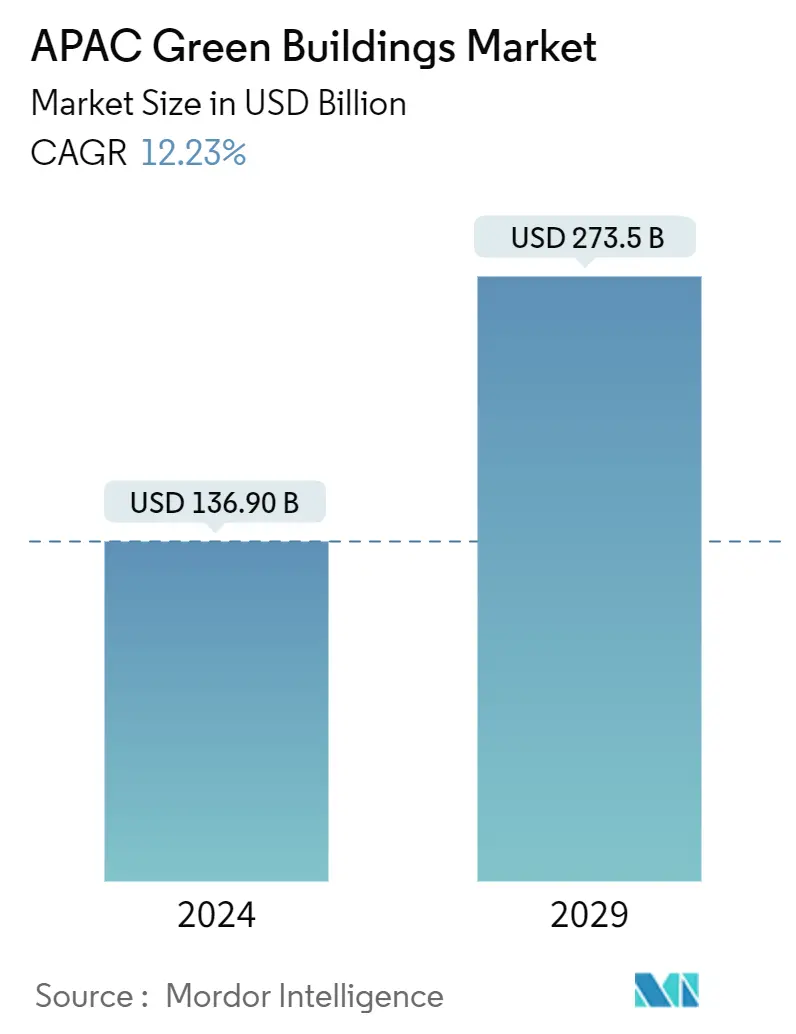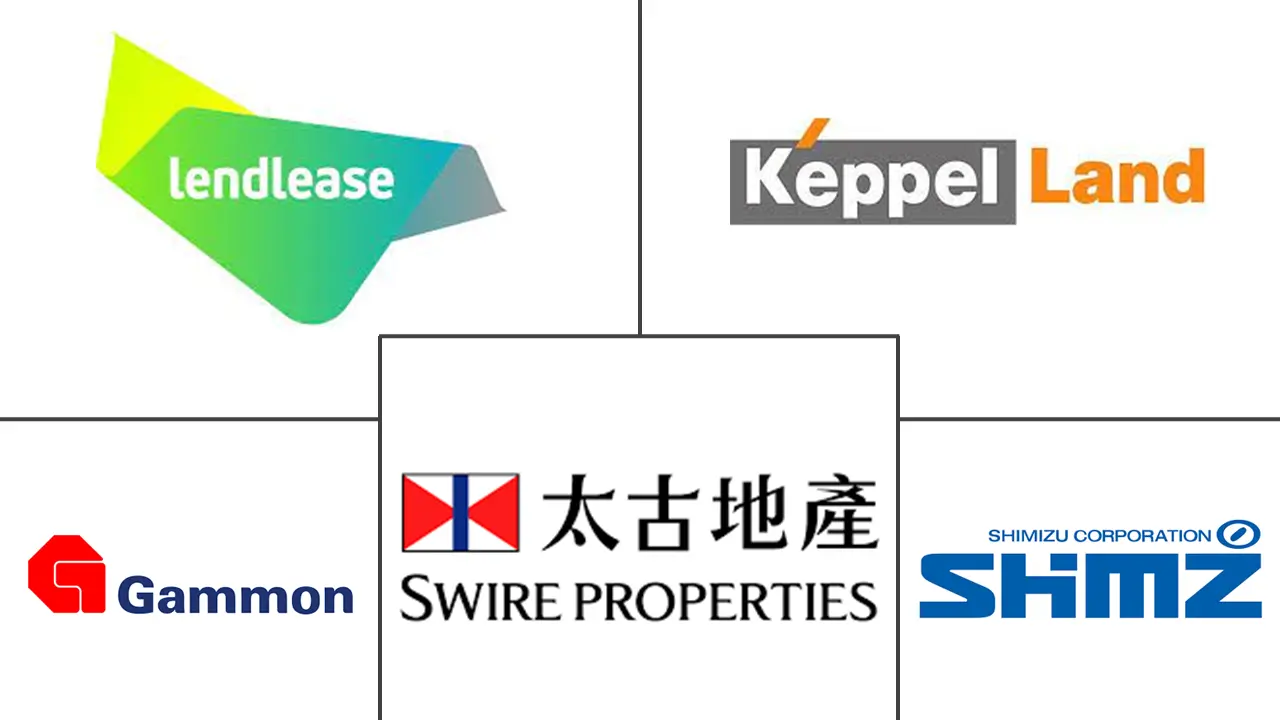Market Size of APAC Green Buildings Industry

| Study Period | 2020-2029 |
| Base Year For Estimation | 2023 |
| Market Size (2024) | USD 136.90 Billion |
| Market Size (2029) | USD 273.5 Billion |
| CAGR (2024 - 2029) | 12.23 % |
| Market Concentration | High |
Major Players
*Disclaimer: Major Players sorted in no particular order |
APAC Green Buildings Market Analysis
The APAC Green Buildings Market size is estimated at USD 136.90 billion in 2024, and is expected to reach USD 273.5 billion by 2029, growing at a CAGR of 12.23% during the forecast period (2024-2029).
- The Asia-Pacific region is home to 60% of the world's 4.3 billion inhabitants, with over 2 billion living in cities. The region is home to 16 out of the 28 world's largest cities (10 million or more people in each city), and the urban population is projected to grow to 3.3 billion by 2050.
- With the growing population, there is a demand for new buildings. Developing low and net zero carbon (NCC) buildings is key to improving people's quality of life, reducing environmental impact, and increasing economic opportunities. Green Building Councils are responding to the challenges and opportunities they face on the ground across the Asia-Pacific Region (APR).
- In most South and Southeast Asian countries, there are mandatory energy efficiency and environmental rating schemes in addition to voluntary schemes. For example, in India, the Energy Conservation Building Code of 2017 and in Sri Lanka, the Energy Building Code of 2020 set energy efficiency and renewable energy use standards.
- Both aim to accelerate the transition to green, energy-efficient buildings. In some cases, the two mechanisms work together to leverage each other's capabilities and resources to increase the multiplier effect in the construction sector. The current certification systems include the GRIHA certification in India, the Green Mark certification in Singapore, and the Greenship certification in Indonesia.
- The sector has evolved significantly since the first set of standards. The latest set of mandatory and optional building standards is putting pressure on the industry to accelerate the transition to net-zero. Net-Zero buildings in South & Southeast Asia include the Indira Paryavaran Bhawan Office building in New Delhi, India Bayalpata Hospital in Nepal, Nepal nzeb@sede campus building in Singapore Uni Kl British Malaysia Institute in Malaysia net zero buildings in South and Southeast Asia.
APAC Green Buildings Industry Segmentation
The green building market is for buildings designed, built, and operated sustainably. This includes buildings with energy efficiency, renewable energy, water efficiency, waste reduction, and indoor environmental quality.
The APAC green buildings market is segmented by product (exterior products, interior products, others (building systems, solar systems, etc.)), by end user (residential, office, retail, institutional, other end users), by geography (China, Japan, India, Australia, South Korea, and the Rest of APAC). The report offers market size and forecasts for the APAC green buildings market in value (USD) for all the above segments.
| By Product | |
| Exterior Products | |
| Interior products | |
| Other Products ( Building Systems, Solar Systems, Etc.) |
| By End User | |
| Residential | |
| Office | |
| Retail | |
| Institutional | |
| Other End Users |
| By Geography | |
| China | |
| Japan | |
| India | |
| Australia | |
| South Korea | |
| Rest of APAC |
APAC Green Buildings Market Size Summary
The APAC green buildings market is experiencing significant growth, driven by the region's rapid urbanization and increasing demand for sustainable construction practices. As urban populations expand, particularly in cities with large populations, there is a pressing need for new buildings that adhere to low and net-zero carbon standards. This shift is crucial for enhancing quality of life, minimizing environmental impact, and fostering economic growth. The region's Green Building Councils are actively addressing these challenges by implementing mandatory and voluntary energy efficiency and environmental rating schemes. These initiatives, such as India's Energy Conservation Building Code and Sri Lanka's Energy Building Code, aim to accelerate the transition to energy-efficient buildings. The adoption of green certifications, like GRIHA in India and Green Mark in Singapore, reflects a growing awareness and commitment to sustainable building practices across the region.
The market is characterized by a competitive landscape, with key players in the construction industry embracing sustainable design principles and collaborating with various stakeholders to meet high sustainability standards. The demand for green buildings is particularly strong in developing countries, where rapid commercialization, industrialization, and urbanization present lucrative opportunities for sustainable investment. Countries like India are witnessing a surge in green building development, supported by government initiatives and policies promoting transparency and accountability in sustainable practices. The market's growth is further bolstered by the involvement of major companies, such as Starbucks, which are expanding their greener store frameworks in the region. As the market continues to evolve, the focus on green retrofitting and the development of new green buildings are expected to play a pivotal role in the region's decarbonization efforts.
APAC Green Buildings Market Size - Table of Contents
-
1. MARKET INSIGHTS
-
1.1 Current Market Scenario
-
1.2 Technological Trends
-
1.3 Insights on Supply Chain/Value Chain Analysis of the Green Buildings Industry
-
1.4 Brief on Different Structures Used in the Green Buildings Industry
-
1.5 Cost Structure Analysis of the Green Buildings Industry
-
1.6 Impact of COVID 19 on the Market
-
-
2. MARKET SEGMENTATION
-
2.1 By Product
-
2.1.1 Exterior Products
-
2.1.2 Interior products
-
2.1.3 Other Products ( Building Systems, Solar Systems, Etc.)
-
-
2.2 By End User
-
2.2.1 Residential
-
2.2.2 Office
-
2.2.3 Retail
-
2.2.4 Institutional
-
2.2.5 Other End Users
-
-
2.3 By Geography
-
2.3.1 China
-
2.3.2 Japan
-
2.3.3 India
-
2.3.4 Australia
-
2.3.5 South Korea
-
2.3.6 Rest of APAC
-
-
APAC Green Buildings Market Size FAQs
How big is the APAC Green Buildings Market?
The APAC Green Buildings Market size is expected to reach USD 136.90 billion in 2024 and grow at a CAGR of 12.23% to reach USD 273.5 billion by 2029.
What is the current APAC Green Buildings Market size?
In 2024, the APAC Green Buildings Market size is expected to reach USD 136.90 billion.

